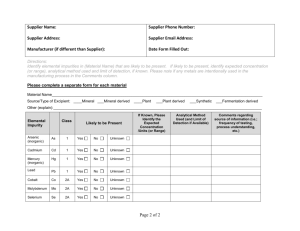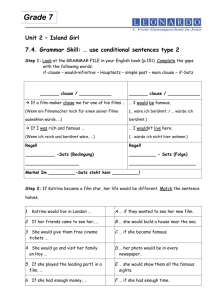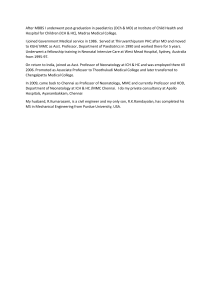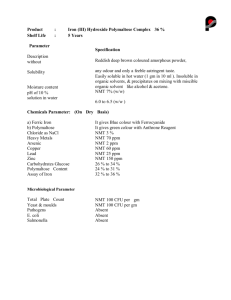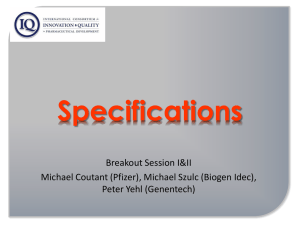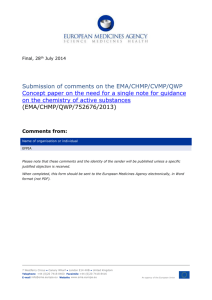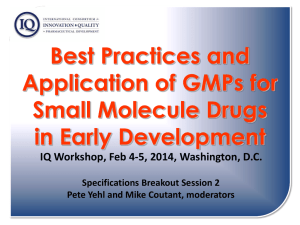Impurities in drug substances / products
advertisement
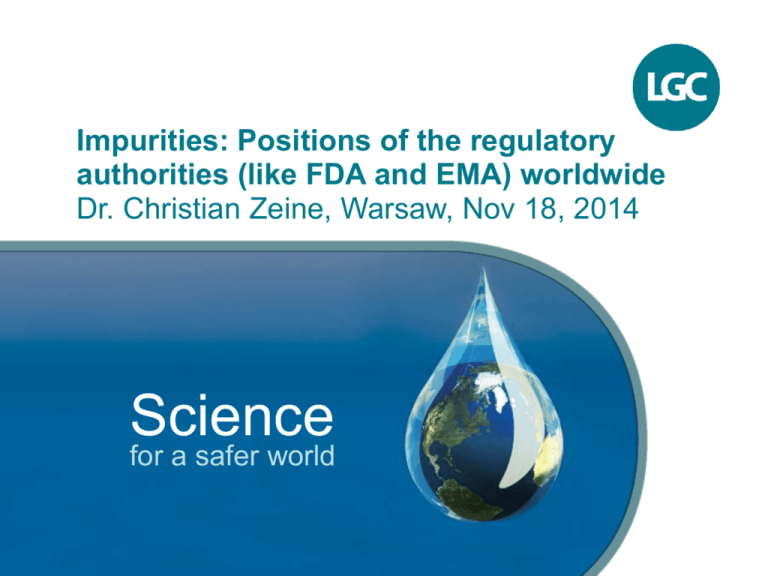
Impurities: Positions of the regulatory authorities (like FDA and EMA) worldwide Dr. Christian Zeine, Warsaw, Nov 18, 2014 Science for a safer world 1 Topics of today‘s talk • Fundamental guidelines from ICH • Influence of ICH impurity guidelines on testing of generic drug substances/products • Practical validation examples 2 ICH guidelines – the basic fundaments • ICH: International Conference on Harmonisation – Members from regulation authorities and industrial pharmaceutical associations – From Japan, USA and Europe – ICH guidelines also considered by authorities in other regions (e.g. PIC/S 48 members and 4 partners) – Also for generics, see next topic (Europe and USA) – Plus considered by further countries – For example Brazil adopted impurity thresholds from ICH Q3A, in December 2013 for generics as well 3 ICH guidelines – the basic fundaments • Three ICH Guidelines important (www.ich.org) – Q3A(R2): Impurities in new drug substances – Q3B(R2): Impurities in new drug products – Q3C(R5): Impurities – Guideline for residual solvents – A fourth one (Q3D) on heavy metal impurities to come – Draft published July 2013, plan to have step 4 status in September 2014 4 ICH guidelines – the basic fundaments • Threshold table ICH Q3A: 5 Topics of today‘s talk • Fundamental guidelines from ICH • Influence of ICH impurity guidelines on testing of generic drug substances/products • Practical validation examples 6 Influence ICH impurity guidelines on generics • Europe – European Pharmacopoeia (Ph.Eur.) • Two documents of importance: General monograph Substances for pharmaceutical use (2034) General chapter Control of impurities in substances for pharmaceutical use (5.10.) • Above documents link applicable Ph.Eur. monographs (new monographs) to ICH Q3A and its thresholds 7 Influence ICH impurity guidelines on generics • Europe – European Medical Agency (EMA): Guideline on Control of Impurities in Pharmacopoeial Substances (CPMP/QWP/1529/04) from 2004 • Guideline requests that marketing approval be granted only when referred-to monographs for pharmacopoeial ingredients are compliant with 2034 and 5.10. • Also guideline requests EDQM not to grant CEPs (certificates of suitability) based on old monographs not compliant with 2034 and 5.10. – Consequences: Broad changes of Ph. Eur. monographs since 2003/2004 • From TLC to HPLC related substances methods, but also to different limits, see examples 8 Ph. Eur. monograph changes, acetylsaliclylic acid Monograph 1/2008 Monograph 1/2011 • Any impurity: NMT 0.1% • Total imps.: NMT 0.25% • Disregard limit: NMT 0.025% • Imps. A-F: NMT 0.15% • Unspecified imps: NMT 0.05% • Total imps.: NMT 0.25% • Disregard limit: 0.03% 9 Ph. Eur. monograph changes, amlodipine besilate Monograph 1/2008 TLC + HPLC methods Monograph 4/2009 only HPLC, noTLC anymore • TLC, any impurity: NMT 0.3%, only 2 imps MT 0.1% • HPLC, imp. D: NMT 0.3% • HPLC, total imps.: NMT 0.3% • HPLC, disregard limit: NMT 0.03% • Imps. A-F: NMT 0.15% • Unspecified imps.: NMT 0.10% • Total imps.: NMT 0.6% • Disregard limit: 0.05% 10 Ph. Eur. monograph changes, ibuprofen Monograph 1/2008 HPLC, imp. F by GC (NMT 0.1%) Monograph 4/2008 HPLC, imp. F by GC (NMT 0.1%) • Imp. B: NMT 0.3% • Imps. A, C-E: NMT 0.3% • Total imps. (w/o imp. B): NMT 0.7% • Disregard limit: NMT 0.05% • Imps. A, J, N: NMT 0.15% • Unspecified imps.: NMT 0.05% • Total imps.: NMT 0.2% • Disregard limit: NMT 0.03% 11 Influence ICH impurity guidelines on generics • USA – USP issued in PF May/June 2014 two draft chapters on impurities to update USP‘s opinion on impurities • New chapter <476>: Organic impurities in drug substances and drug products • Amendment to <1086>: Impurities in drug substances and drug products – Chapter also features the ICH thresholds – New chapter resp amendment was necessary to be in consistence with FDA approach • Monograph changes already ongoing 12 Influence ICH impurity guidelines on generics • USA – FDA issued two guidances for industry ANDAs: Impurities in drug substances / products • June 2009 (drug substances), November 2010 (drug products) – Statement there • ICH Q3A and Q3B were developed for new drug applications (NDAs) • However, FDA takes position that ICH principles are applicable to ANDAs (abbreviated NDAs, i.e. generic products) as well: “FDA believes that much of the content of the Q3A(R) guidance applies to ANDAs. See especially sections I through V and the Attachment, Thresholds.” 13 New FDA impurity guidance: Relevant points • Setting acceptance criteria – First point of reference: Pharmacopoeias (namely USP) • If impurity specified in USP, then specification there should be kept • If pharmacopoeia specification cannot be kept then impurity enters into qualification process – If impurity is not specified in compendia • Use decision tree provided (based on ICH design) 14 New FDA impurity guidance: Decision tree (!) (!) (!) Check impurity level with a dedicated reference standards before taking further actions! 15 Topics of today‘s talk • Fundamental guidelines from ICH • Influence of ICH impurity guidelines on testing of generic drug substances/products • Practical validation examples 16 Validation guideline ICH Q2(R1), parameters 17 Examples • Specifity of HPLC assay method (1) – Show absence of interference of • • • • solvent, matrix (in case of drug preparation), mobile phase, and of the individual (specified) impurities. 18 Examples • Specifity of HPLC assay method (2) – Chromatograms (Drug Product, 3 specified imps.) Blank Imp. A Placebo Imp. B 19 Examples • Specifity of HPLC assay method (3) – Chromatograms (Drug Product, 3 specified imps.) Imp. C Imp. A Imp. B API Imp. C API XYZ Imp. B Chromatogram of the API and all three impurities (imps. at limit conc.) Need to define resolution criteria (SST) at this point at the latest 20 Examples • Specifity of HPLC assay method (4) – Alternatively, set up two analytical series of drug product – One with original drug product • Another one with imps. spiked in, preferably to maximum concentration – Do statistical analysis (t-Test, additionally F-Test) 21 Examples • Specifity of HPLC assay method (5) – Statistical approach Series 1 (mg API/dosage form) Mean value Standard deviation Series 2 (imps. spiked) (mg API/dosage form) 19,62 19,74 20,12 19,52 19,76 19,64 19,98 19,34 19,86 19,72 19,66 19,8 19,83 19,63 0,19 0,17 t-Test and F-Test show a coincidental difference. The test value for the t-Test (significance in mean value!) is 1.92, being lower than the tabulated value (t(5%;10)=2.228) => statistically no difference. The test value for the F-Test (significance in standard deviation!) is 1.25, being lower than the tabulated value (F(5%;5,5)=5.05) => no systematic deviation. 22 Examples • Accuracy (trueness) of impurity determination by HPLC (1), example acetylsalicylic acid – Recovery of impurity A (spiked into drug substance) – Range from reporting level - 120% of specification (spec. 0,15%) (0.05-0.18%, resp. 0.15-0.54 mg for 300 mg samples) – See ICH Examples • Accuracy (trueness) of impurity determination by HPLC (2), example acetylsalicylic acid – See ICH Examples • Accuracy (trueness) of impurity determination by HPLC (1) – Range from reporting level - 120% of specification (spec. 0,15%) (0.05-0.18%, resp. 0.15-0.54 mg for 300 mg samples) Level (%) 0,05 0,1 0,15 0,18 Amount added (µg) Amount found (µg) Recovery rate (%) 155 158 101,7 161 162 100,9 164 162 99,1 303 301 99,3 306 304 99,3 295 292 98,8 454 457 100,6 459 456 99,3 444 437 98,5 545 542 99,5 551 549 99,6 531 530 99,7 Recovery at level (%) 100,6 99,1 99,5 99,6 Topics of today‘s talk • Fundamental guidelines from ICH • More and more accpeted worldwide, not just in core ICH regions • Influence of ICH impurity guidelines on testing of generic drug substances/products • Will increase further, already the case in Europe/USA/Brazil • Reference standards important for correct measurements • Practical validation examples • Neat impurity materials (reference standards) most effective tool for validation tests 26 QUESTIONS? Now, or to christian.zeine@lgcstandards.com 27
